
During the 10th Annual Empire Poultry Palace Show, which took place at the Grand Central Palace on Lexington Avenue in December 1916, “movie cats” and “Christmas kittens” were the talk of the town.
Although the first National Cat Show at Madison Square Garden II in May 1895 is often cited as the first cat show in America, there were actually quite a few cat shows in New York City and other American cities before this “official cat show” took place at the Garden. During the late 1800s, New York poultry and pet-stock shows often included a cat exhibit as a secondary attraction. Groups such as the New York Poultry, Pig, and Stock Association and Empire Poultry Club managed the shows, which often attracted thousands of entries, including hundreds of cats.
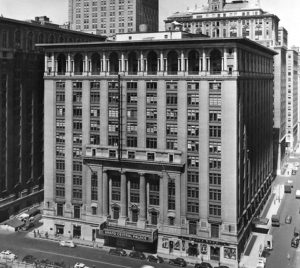
The Empire Poultry Show took place at the Grand Central Palace, which occupied the air rights over the railroad tracks leading into Grand Central Terminal (the entire block of Lexington Avenue between 46th and 47th Streets).
Movie Cats Steal the Show
In 1916, “movie cats” were one of the chief, surprise new attractions of the show. The hens and chicks and other fowl couldn’t hold a candle to these cats, who were mostly pedigree blues and smokes that were leased to moving picture operators when there was a need for a cat to play a vital role in the story.
The $500 aristocratic kitties were also no match for the movie cats, who were expected to “take away the ribbons” from the placid show cats “that never in all their experiences had anything like this happen to them before.”
According to the New York Times, these special cats were accomplished movie stars who “photographed beautifully when it came to close ups” and never turned a hair in the most thrilling of scenes and stunts.” They were reportedly in great demand by all the studios.
Because the movie cats knew how to pose on command, they were expected to “get the eye of the judges and prove formidable rivals to the calm and unemotional, costly, wonderfully groomed $500 and up pussies that hitherto have swept the classes and are the aristocrats of catdom.”
The movie cats were owned by Elizabeth Kingston, who owned a cattery in the Van Nest neighborhood of the Bronx. Miss Kingston had established her cattery in 1911, and she specialized in Persian and Angora cats.
Miss Kingston moved her cattery (called the Kingston Kattery) to Brentwood, Long Island, in 1919. Sadly, 24 of her prize-winning cats were killed in 1921 when a careless attendant improperly adjusted an oil stove, causing excessive fumes and smoke which suffocated the cats.
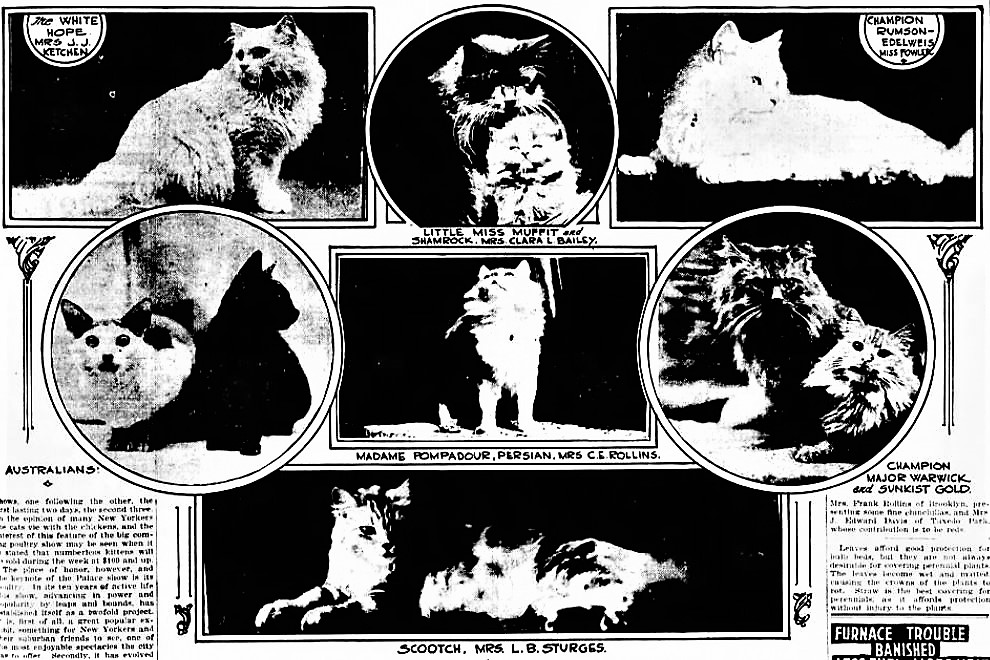
Here are some of the many cats featured at the Grand Central Palace show in 1916.
Christmas Kittens Are Also a Big Hit
With two cat clubs combined at the 1916 show (the Empire Cat Club and Westchester Cat Club), a “bull market” on pedigree kittens was projected, especially since a very damp summer that year had been especially hard on the tiny fur balls, many of whom did not survive. In order to take advantage of the expected high demand, the show advertised “Christmas Kittens” for sale. It was hoped that some of these special holiday kitties would sell for $100 or more.
The Christmas Kittens were primarily white cats, but some “red” cats — white cats with a faint hint of pink tinge to the fur — were also in high demand. These cats in particular were expected to steal away all the attention from the poor little chicks who normally stole the show. In fact, many people called the show that year the “Christmas Kitten Show.”
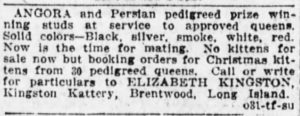
Even Elizabeth Kingston got in on the Christmas kitten craze. She would often place ads in the paper announcing that she was booking orders for Christmas kittens.
Judges for the cat show included Clara N. Bailey of 88 Joralemon Street in Brooklyn, whose prize-winning smoke Bendola (a performing cat that starred on Broadway) was a crowd favorite. Mrs. Harriet V. Furrniss (perfect name) of New York, F.Y. Martin of Greenwich, Connecticut, and Miss Jennie Kroeh of Orange, New Jersey, were the other judges.
The Grand Central Palace
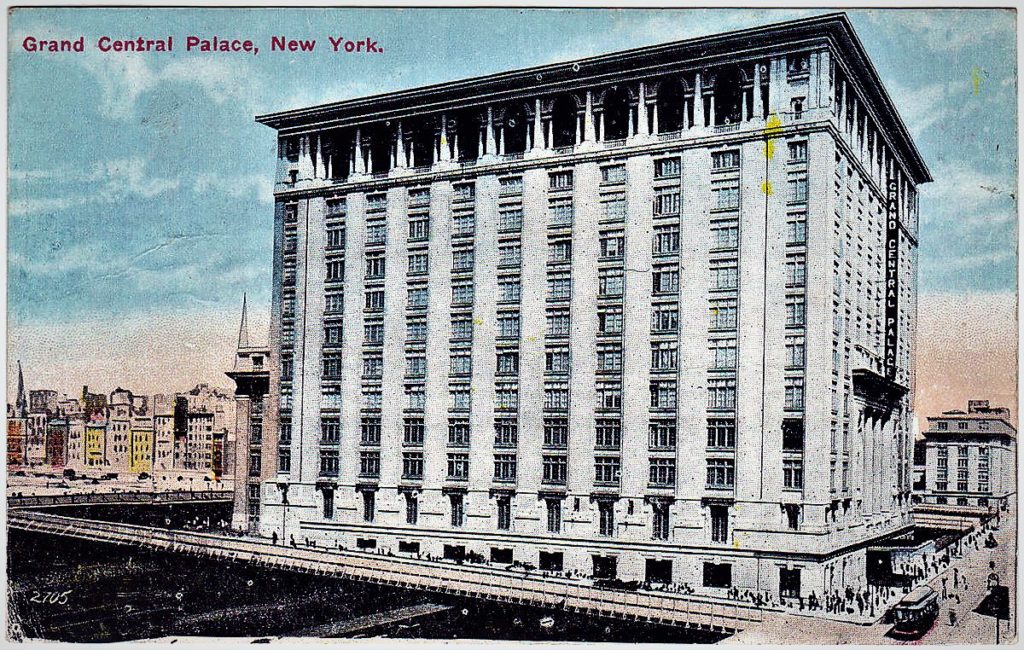
The Grand Central Palace, 1911-1963.
The original Grand Central Palace exhibition hall was constructed in 1893 on Lexington Avenue between 43rd and 44th Streets. At that time, the original Grand Central Terminal (called the Grand Central Depot Railway Station), which had been constructed in 1871, was still standing.
In 1904, a year after construction began on the new Grand Central Terminal, the New York Central Railroad bought two blocks of land east of the future terminal, bounded by Lexington Avenue, Depew Place, and 43rd and 45th Streets. This land acquisition included the old Grand Central Palace, which served as a temporary train station during the terminal’s construction.

Construction of the new Grand Central Terminal began in June 1903. This photo of the excavation site was taken in 1908.
The new Grand Central Palace, which opened in 1911, occupied the air rights over the railroad tracks leading into the new Grand Central Terminal (which was still under construction). Basically, the building took up the entire block of Lexington Avenue between 46th and 47th Streets.
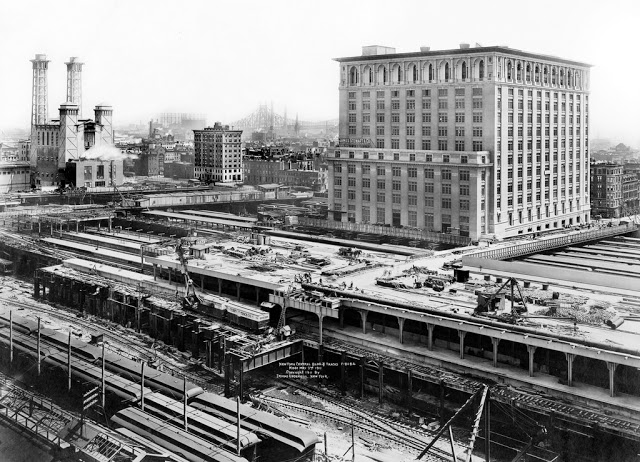
Here’s the Grand Central Palace on May 2, 1911. Grand Central Terminal would not officially open until February 2, 1913.

The exhibition areas occupied the first four floors of the Grand Central Palace, with a main exhibition area carved out of the second and third floors to create an interior volume 48 feet high. The main floor could accommodate 94 booths, which were typically about 320 square feet each. Here’s a photo of the New York Auto Show in 1927.
The exhibit hall continued to operate until 1963. The 13-story building where Christmas kittens once took center stage was demolished to make way for a 48-story office tower at 245 Park Avenue.



